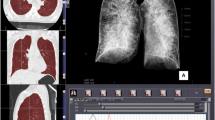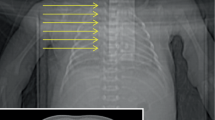Abstract
Nowadays, the modern computed tomography techniques are more and more applied in forensic investigations. The detection of abnormalities in post-mortem computed tomography (PMCT) imaging of the lungs is very common. As in clinical imaging, also in post-mortem imaging the right interpretation of alterations has an extreme importance for the assessment of correct conclusions. This is even crucial when the radiologist who approaches the PMCT images is not routinely involved in forensic cases. The aim of this article is to provide radiologists who approach PMCT imaging cases with some indications for a proper and correct interpretation of pulmonary findings, to avoid misleading forensic conclusions. Particularly, the following issues will be addressed: PMCT imaging of post-mortem changes of the lungs; PMCT imaging of pathological lungs [(a) in thoracic trauma cases, (b) in cases without thoracic trauma]. Finally, the possible pitfalls in interpretation of PMCT imaging of the lungs will be also discussed.








Similar content being viewed by others
References
Pomara C, Fineschi V, Scalzo G, Guglielmi G (2009) Virtopsy versus digital autopsy: virtual autopsy. Radiol Med 114(8):1367–1382
Proisy M, Marchand AJ, Loget P et al (2013) Whole-body post-mortem computed tomography compared with autopsy in the investigation of unexpected death in infants and children. Eur Radiol 23(6):1711–1719
Filograna L, Laberke P, Ampanozi G et al (2015) Role of post-mortem computed tomography (PMCT) in the assessment of the challenging diagnosis of pericardial tamponade as cause of death in cases with hemopericardium. Radiol med 120:723–730
Germerott T, Preiss US, Ebert LC et al (2010) A new approach in virtopsy: postmortem ventilation in multislice computed tomography. Leg Med (Tokyo) 12(6):276–279
Miller WS (1947) The lung. Charles C Thomas, Springfield
Zerhouni EA, Naidich DP, Stitik FP et al (1985) Computed tomography of the pulmonary parenchyma: Part 2. Interstitial desease. J Thorac Imaging 1:54–64
Vock P, Malanowski D, Tschaeppeler H et al (1987) Computed tomographic lung density in children. Invest Radiol 22:627–631
Rosenblum LJ, Mauceri RA, Wellenstein DE et al (1980) Density patterns in the normal lung as determined by computed tomography. Radiology 137:409–416
Millar AB, Denison DM (1989) Vertical gradients of lung density in healthy supine men. Thorax 44:485–490
Robinson PJ, Kreel L (1979) Pulmonary tissue attenuation with computed tomography: comparison of inspiration and expiration scans. J Comput Assist Tomogr 3:740–748
Verschakelen JA, Van Frayenhoven L, Laureys G et al (1993) Differences in CT densities between dependent and nondependent portions of the lung: influence of the lung volume. A J Roentgenol 161:713–717
Kauczor HU, Hast J, Heussel CP et al (2002) CT attenuation of paired CT scans obtained at full inspiratory/expiratory position: comparison with pulmonary function tests. Eur Radiol 12:2757–2763
Webb WR, Stern EJ, Kanth N et al (1993) Dynamic pulmonary CT findings in normal adult man. Radiology 186:117–124
Stern EJ, Webb WR (1993) Dynamic imaging of lung morphology with ultra-fast high-resolution computed tomography. J Thorac Imaging 8:273–282
Shiotani S, Kohno M, Ohashi N, Yamazaki K, Nakayama H, Watanabe K, Oyake Y, Itai Y (2004) Non-traumatic postmortem computed tomographic (PMCT) findings of the lung. Forensic Sci Int 139:39–48
Durlacher SH, Banfield WG Jr, Bergner AD (1950) Post-mortem pulmonary edema. Yale J Biol Med 22:565–572
Shiotani S, Kobayashi T, Hayakawa H, Kikuchi K, Kohno M (2011) Postmortem pulmonary edema: a comparison between immediate and delayed postmortem computed tomography. Leg Med (Tokyo) 13:151–155
Polson CJ (1962) The essentials of forensic medicine, 2nd edn. Arnold, London, pp 6–7
Di Maio DJ, Di Maio VJM (1989) Forensic pathology. Elsevier, London, pp 21–25
Camps FE (1976) Gradwohl’s legal medicine, 3rd edn. John Wright & Sons, Bristol, pp 81–82
Knight B (1996) Forensic pathology, 2nd edn. Arnold, London, pp 55–59
Christe A, Flach P, Ross S, Spendlove D, Bolliger S, Vock P, Thali MJ (2010) Clinical radiology and postmortem imaging (Virtopsy) are not the same: specific and unspecific postmortem signs. Leg Med (Tokyo) 12(5):215–222
Webb WR, Müller NL, Naidich DP (2009) High-resolution CT of the lung. Lippincott Williams & Wilkins, Philadelphia, pp 118–128
Webb WR, Müller NL, Naidich DP (2009) High-resolution CT of the lung. Lippincott Williams & Wilkins, Philadelphia, p 169
Levy AD, Harcke HT, Getz JM et al (2007) Virtual autopsy: two- and three-dimensional multidetector CT findings in drowning with autopsy comparison. Radiology 243:862–868
Christe A, Aghayev E, Jackowski C et al (2008) Drowning-post-mortem imaging findings by computed tomography. Eur Radiol 18:283–290
Vander Plaetsen S, De Letter E, Piette M, Van Parys G, Casselman JW, Verstraete K (2015) Post- mortem evaluation of drowning with whole body CT. Forensic Sci Int 249:35–41
Lo Re G, Vernuccio F, Galfano MC et al (2015) Role of virtopsy in the post-mortem diagnosis of drowning. Radiol Med 120(3):304–308
Filograna L, Bolliger SA, Ross SG, Ruder T, Thali MJ (2011) Pros and cons of post-mortem CT imaging on aspiration diagnosis. Leg Med (Tokyo) 13:16–21
Filograna L, Ross S, Bolliger S, Germerott T, Preiss U, Flach P et al (2011) Blood aspiration as a vital sign detected by post-mortem Computed Tomography (CT) imaging. J Forensic Sci 56:630–637
Author information
Authors and Affiliations
Corresponding author
Ethics declarations
Conflict of interest
The authors declare that they have no conflict of interest.
Ethical approval
All procedures performed in studies involving human participants were in accordance with the ethical standards of the institutional and/or national research committee and with the 1964 Helsinki declaration and its later amendments or comparable ethical standards.
Informed consent
Not-applicable to post-mortem examination. In all cases the Justice Department gave consent to the CT examination.
Rights and permissions
About this article
Cite this article
Filograna, L., Thali, M.J. Post-mortem CT imaging of the lungs: pathological versus non-pathological findings. Radiol med 122, 902–908 (2017). https://doi.org/10.1007/s11547-017-0802-2
Received:
Accepted:
Published:
Issue Date:
DOI: https://doi.org/10.1007/s11547-017-0802-2




